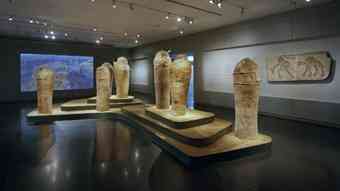THE Israel Museum reopened its doors this week after a three-year renovation to tell its story anew, a local story that half the world recognises as their story too.
 The curators did not need to look far past the museum's front door in Jerusalem to understand what it was they had to tell. Only about 100km away, in the Jordan Valley, ancient humans paused 1.5 million years ago for several millennia on their trek out of Africa, finding a place in the food chain before moving on. In Jerusalem, the great monotheistic religions took shape as intermediaries between humans and the unknown.
The curators did not need to look far past the museum's front door in Jerusalem to understand what it was they had to tell. Only about 100km away, in the Jordan Valley, ancient humans paused 1.5 million years ago for several millennia on their trek out of Africa, finding a place in the food chain before moving on. In Jerusalem, the great monotheistic religions took shape as intermediaries between humans and the unknown.
Here the Bible was written and in an ineffable moment 23 centuries ago, barely 3km from the museum, the scribe Ezra mounted a podium to read portions of it aloud for the first time to the common folk of Judah.
So rich with resonance are the items in the museum's possession that director James Snyder, who orchestrated the $US100 million ($112m) renovation, decided less is more. Even though the museum's exhibition space has been doubled, the number of items on display is less than before in order to enable a less cluttered and more coherent presentation. The bulk of the museum's 500,000 items lies in its storerooms, to be shown from time to time in temporary exhibitions.
Beyond the intrinsic value of its collections, the Israel Museum has a magna role beyond that played by museums abroad. With religiosity no longer the universal bond among Jews around the world that it was, culture and folk memory occupy the centre of Jewish ethnic consciousness. If this be the new religion, the Israel Museum is its temple.
In another context, the museum plays an important political role in a neighbourhood where leaders such as Iran's President Mahmoud Ahmadinejad declare Israel has no right to exist and where Muslim clerics declare there never was a Jewish temple in Jerusalem and that Jews have no historic claims on the city. The Israel Museum makes it clear it is an affirmation of a vibrant Jewish culture in the land going back 3000 years. If this does not make an impression on Israel's enemies, it does with Israelis, confirming an important layer of identity that underlies the national will and provides cohesiveness in the face of existential danger.
The Israel Museum was conceived in the 1960s by Teddy Kollek, a close aide to Israel's founding father, David Ben-Gurion. Kollek believed it vital for Israel to have a cultural icon regardless of the desperate state of the country's economy. Raising funds from wealthy Jews abroad, he pushed through the construction of the museum on a hilltop opposite the Knesset a handsome ensemble of white pavilions echoing in modern form a Greek village. It opened in December, 1965.
In 1996, Snyder was named museum director. He had spent the previous 22 years at New York's Museum of Modern Art, the last 10 as deputy director, and was ready for a change. The Israel Museum had developed three main wings, he discovered: archaeology, fine arts and Judaica. The physical layout of the 8ha museum campus was awkward, obliging visitors to walk up a steep approach to reach the entrance, and lacking a fluent connection between the wings. These problems were resolved by American architect James Carpenter, hired by Snyder.
The Judaica section, now known as the Wing for Jewish Art and Life, has been enhanced by the interior of a striking 18th-century synagogue from Suriname, to which Jews from Spain and Portugal had fled to escape the Inquisition. Its most prominent feature is the white sand that covers the floor, said to symbolise the wandering of the Jews in the Sinai desert. It joins three other synagogues, from Germany, Italy and India, in the wing's collection.
The fine arts wing has been greatly expanded and includes for the first time a permanent gallery for Israeli art.
It is probably the archaeological wing, however, that draws most interest due to the abundance of finds made by Israeli archaeologists in the past 40 years. Little more than a century ago, the oldest known biblical text dated to the 10th century. The discovery of the Dead Sea Scrolls (also on display) in the late 1940s pushed that date back about 1200 years. In 1986, two small silver amulets with writing on them were found in a Jerusalem tomb They proved to have been written in the seventh century BC.
Known as the Priestly Benediction, it is still part of the synagogue liturgy. The discovery touched off a lively scholarly argument about when the Bible was composed.
A thumbnail-size piece of carved flint from the Golan, ostensibly showing a fertility goddess, is dated at 325,000 years ago and is claimed by scholars to be the oldest object sculpted by man.
Although Jewish artefacts predominate, the collection includes Islamic and Christian items as well. Among the latter is part of a large wall painting from the refectory of a crusader abbey in Jerusalem that warns those who gossip about persons not present "have no place at our table".
What interests Snyder, he says, is to have museum visitors "experience the unfolding of material culture from the start of time until today".
Many cultures are represented but Snyder emphasises the universality of the human experience. "The museum is about the resonance of cultures," he says, "not the distinctions."
Source: The Australian [July 31, 2010]